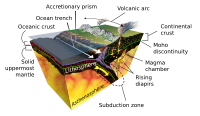
Photo from wikipedia
Abstract Tectonic melange fragments (metabasalt and metadiabase) in the ophiolitic serpentinites of the Egyptian Eastern Desert show peculiar mineral assemblages and they provide useful insights into metamorphism and metasomatism. New… Click to show full abstract
Abstract Tectonic melange fragments (metabasalt and metadiabase) in the ophiolitic serpentinites of the Egyptian Eastern Desert show peculiar mineral assemblages and they provide useful insights into metamorphism and metasomatism. New field and mineralogical data indicate the formation of rodingite at the expense of mid-ocean ridge basalt (MORB) at three localities, namely Wadi Sikait, Wadi Abu Rusheid and Hafafit (SRH belt). These rocks occupy a lower structural horizon in the tectonic melange zone(s), whereas ocean-island and arc basalt and diabase (OIB) is relatively younger with no evidence of rodingite formation. Rodingitization starts at slow-ultraslow spreading centers and continued until subduction and exhumation at an accretionary wedge. It is a process that is characterized by Ca-rich fluids and the development of a complicated “blackwall” due to superimposed K+ and Mg2+-metasomatism. Oxygen fugacity is fluctuating where it is high for Hafafit and low for Wadi Abu Rusheid rodingites. The Ta/Yb-Th/Yb ratios suggest that rodingitization is not contemporaneous with serpentinization in an island-arc environment but with serpentinization near seamounts at the spreading centers. Combined field observations, whole-rock geochemistry and mineral chemistry data prove that rodingites are formed at the expense of a MORB (mid-ocean basalt) protolith and occupies a lower structural position than unrodingitized IAT (island-arc tholeiite) metadiabases.
Journal Title: Lithos
Year Published: 2019
Link to full text (if available)
Share on Social Media: Sign Up to like & get
recommendations!